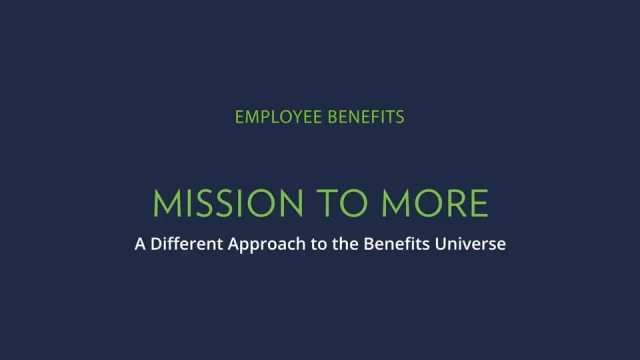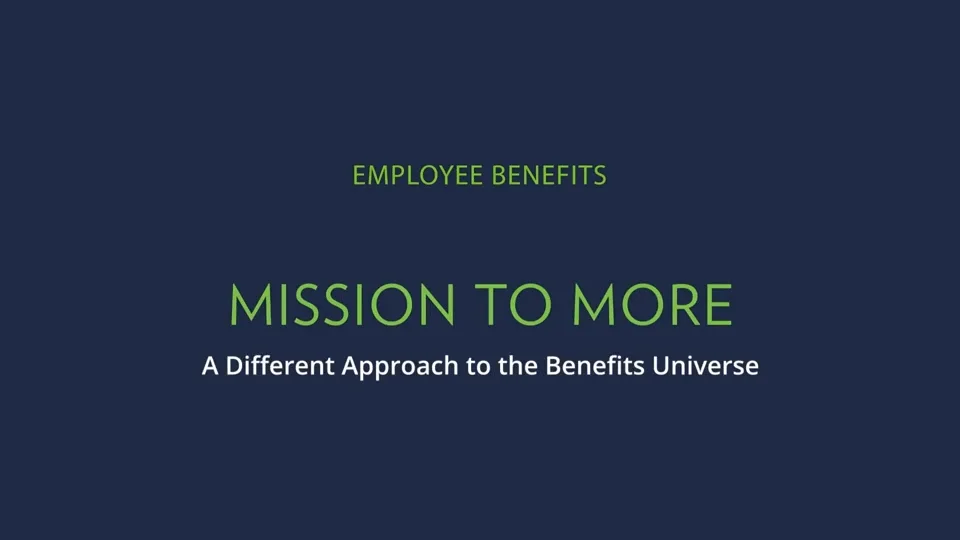Blog
What’s Next in Benefits: Emerging Solutions for the Workplace
Get up to speed with the latest on how you can boost your employee benefits program to “do more.”
Employers must rapidly adjust to the changing workforce, providing more than just a traditional benefits experience. Our Mission to More series offers guidance from leading experts on what employees want and how employers can adapt to the new benefits universe.
In our webinar, What’s Next in Benefits: Emerging Solutions for the Workplace, Woodruff Sawyer’s former Employee Benefits Practice Leader Kathy Prosser partnered with Dave Kerrigan, CEO of BenefitPitch to interview four innovative firms in the Benefits space that are rethinking how benefit plans access primary care, perks, and mental health in 2022.
In this recap, get up to speed on the latest in virtual healthcare, on-demand healthcare services, ways to simplify perks, and how you can boost your employee benefits program to “do more.

Amazon Care: Reinventing Primary Care
Speaker: Alex Bertha, Product Lead, Employer Segment, Amazon Care
What they do: Amazon Care is healthcare built around you, your life, and your schedule.
Alex describes Amazon Care as what the primary care concept would be if we could rebuild it from the ground up using today’s technologies, instant access to teams of doctors and nurses, and a seamless blend of virtual and in-person care.

One study that stays with Alex is the data that shows that a Primary Care Provider (PCP) is effectively the CEO of a $10 million downstream business, with annual recurring revenue based on the power of where they send the patient and what they prescribe. In total, PCPs control $1 billion in downstream spend, funded mainly by employers. Realizing that if they looked internally within Amazon for answers, they could help create a solution for all employers.
Making healthcare easy is deceptively simple but requires looking at the entire primary and urgent care spectrum. “It requires us to dive deep into the technical, operational and financial complexity of health care to abstract that away from customers.” Amazon Care evaluates everything from required services, price transparency, and customer satisfaction, all through available through an app. By providing dedicated care teams, clinicians on the patient’s schedule, and in-home visits, they provide a fully integrated approach to healthcare.
Amazon Care is looking to collect demographic, gender, and race ethnicity data to study disparities in different employer groups. Alex commented that Amazon Care “can look to understand the individual level where gaps exist beyond the care delivery model,” including food or housing insecurity.
Amazon Care is currently virtual in 50 states, with plans to add over 20 in-person care markets in 2022 alone, getting into the rhythm of expanding and scaling the service.
Compt: Personalized benefits with 90% utilization
Speaker: Amy Spurling, CEO & Founder, Compt
What they do: The #1 way to offer reimbursed employee perk stipends to your global and remote teams, while fully complying with tax law.
It can be tough to pick the right suite of benefits for your workforce as an employer. While healthcare and behavioral health benefits are now table stakes, how do you offer personalized benefits that employees will use?
Compt offers software for employers to distribute stipends instead of individual benefits that may go unused. Stipends meet employees where they are, right-size the employer’s budget, reduces HR admin time, and offers the only tax-compliant stipend software. As an innovative platform, Compt recently won SHRM’s first Shark Tank-like technology challenge, the Better Workplaces Challenge Cup.

After a study of 8,600 employees, Compt discovered employers used over 27,000 vendors to offer personalized benefits, with each employee choosing three unique vendors for their perks. However, Amy noted that this approach is not feasible for any HR department to manage, preventing employers from reaching ROI and utilization goals.
Employers choose the category of offerings that they will reimburse with stipends, including learning and development, health and wellness, meal plans, remote employee needs, family, and equipment stipends. Employers process stipends through integrations with popular payroll applications, making the process easy and tax compliant.
Amy noted that stiped utilization could reach 90%, giving employers more bang for their buck while offering personalized benefits for their employees. DEI is an inherent part of this process, allowing employees to choose the type of benefits that suit them instead of their employer dictating the selection. “You will actually allow for a much broader interpretation of what wellness or development means to your employees,” said Amy.
Compt serves global clients in 60 countries, supporting any currency in any time zone across multiple industries.
Brightline: Solutions for urgent pediatric behavioral health
Speaker: Haleigh Tebben, Chief Commercial Officer, Brightline
What they do: Brightline addresses the nationwide problem of urgent pediatric behavioral health
Pre-COVID, one in five children were diagnosed with behavioral health issues, with an additional one in five remaining undiagnosed. As a result, parents must solve the problem, balancing work and child health issues. That’s why 21% of employees have left or considered leaving their job, while 36% spend five or more hours per week trying to solve their child’s behavioral health issues. In addition, nearly 80% of US counties do not have a child psychologist. In short, the system is broken, leaving employees to navigate a difficult journey.

Brightline provides a comprehensive model that uses a digital platform to help parents and caregivers understand what support they truly need for their child or teen. Unfortunately, in today’s climate, parents will head to the Emergency Department for urgent care, to the pediatrician for a new medication, or to a therapist—when they may not need to. Brightline offers a spectrum of support that starts with coaching and providing the right clinical resources, including teletherapy, offering more options than just urgent or clinical care.
Brightline recognizes the diverse nature of its clients. To make sure they are inclusive, they recognize the backgrounds of kids, teens, and parents so they can see themselves in our product. Haleigh said they would be rolling out provider-matching solutions this year to ensure parents, caretakers, and kids receive care from someone with whom they identify.
Brightline hires its own clinicians and therapists, bringing them in-network with major health plans. Brightline currently has five network relationships, with more on the horizon. “It’s very easy for an employer to turn us on by opting in with their health plan, primarily in a self-funded world.” While open to health plans, the ideal size for self-funded employers is about 500, given the number of dependents on the plan. Brightline is very excited to support employees across multiple industries, including direct-to-consumer options.
Papa: Caretaking Help at Your Front Door
Speaker: Nick Pinto, Director of Employee Partnerships, Papa
What they do: Provide vital social support to members, for family care that’s like family
The US population is aging fast. Currently, there are over 56 million Americans over age 65, growing to 70 million by 2030 and 85 million by 2040. Given this explosive growth, how will people continue to care for their parents, children, and loved ones who are non-critical but still require support? Even a trip to the hospital may mean that the employee may need help just getting around the house.
Papa is a US-based company that offers caretaking benefits by “Papa Pals”, who can provide anything from checking in on an aging parent to watching the kids after school. In addition, Papa goes beyond the limits of today’s healthcare system by addressing the social determinants of health, including loneliness and isolation, transportation, health care literacy, and technology.

Nick noted that Papa is trying to improve work-life balance by helping employees care for those who need it, whether a local errand or checking in on dad on the other side of the country. Employers pay an activation fee for every employee to get started with benefits, available in 12 and 24 hours of help. Employees do have the option to buy up more hours for more caretaking assistance.
The Papa executive team has been recognized for its gender and racial parity pledge and includes leaders and board members across genders and racial-ethnic backgrounds. Papa also looks to pair employee needs with Papa Pal across language, gender, age, interest, and other social characteristics. Members can match the suitable Pal for their loved one (or themselves) through their mobile app or phone call. Papa Pals get to do meaningful work on their own schedule and choose the clients that are right for them.
Papa currently works with employers from 100 to 100,000 employees across all 50 states, with plans on expanding to four countries.
Navigating the New Benefits Universe
Our panelists provided just a few of the rapidly emerging trends that affect your employees’ choice of benefits. Your benefits consultant can help you navigate the changing universe of benefits, helping to serve employees and stay budget friendly.
Table of Contents









